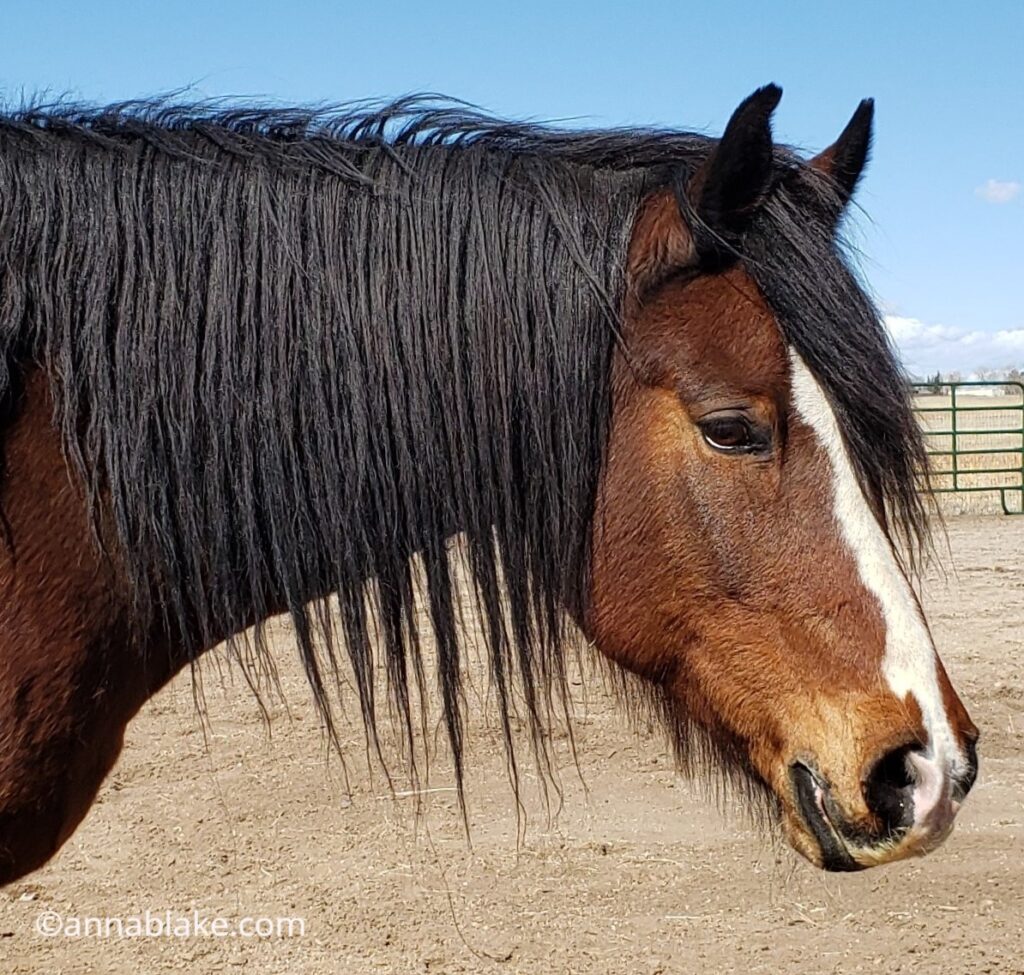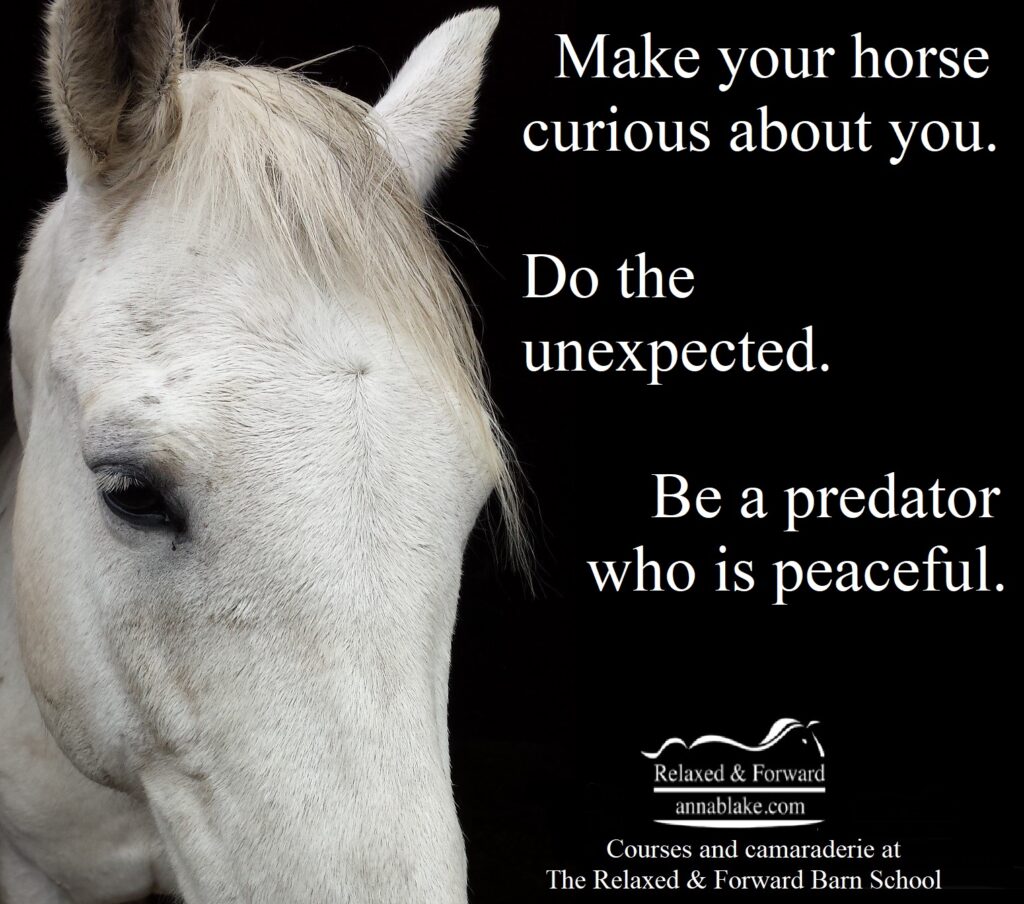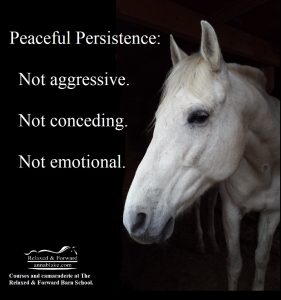
The first video is of a Mustang, proud and breathtakingly beautiful. He’s a burnished smoky buckskin, with a massive neck and a straight face that shows more strength than refinement. He’s a horse’s horse. Standing in his pen, he is still, his lips tight and his eyes dark. The horse is waiting for the woman to ask something of him. Because humans always ask something of him. The woman is deliberately ignoring him. She fusses with a feed pan on the ground, moves some leaves with her foot, and studiously does anything but ask him for something. An eternity of minutes has passed and expectation hangs in the air.
Then the Mustang lowers his head so he can stretch his neck. He gives his ears a small shake and licks. Then the yawning begins. He is releasing anxiety. I describe this kind of release as letting go of dread, because it’s a hard word that offends us a little. It makes us more aware of how we present ourselves. Our body language is usually loud, sometimes with anger, more often with love. But always our presence rattles. Most of us hurry. We assume horses are dying to see us. Horses think we are all narcissists. That we’re bulls in a china shop.
The Mustang has never faced cruelty other than being rounded up. Like domestic horses, he freezes a bit when we come close. But on this day, the woman disappointed the Mustang’s expectations. She has let the air rest. She is engaged with the environment, not him. In simple terms, she’s playing hard to get, and he was totally engaged with her every move. And after the yawn fest, he moved closer to the woman. She has become interesting and mysterious to the Mustang, as he has always been to her. They are negotiating a new language.
This video, and others I’ll mention, are from an advanced class at The Barn School. The people are untraining their horses. It’s a necessary step for horses with history. This group is starting their horses over by clearing away emotional debris from the past. Without this step, retraining will not give us a reliable partner. It’s a method of earning trust and it takes time. But once we restore that confidence, the rest comes quick and easy.
I worry social media has impacted the way we handle horses, putting us all in a weird competition. Can anyone explain to me the how laying down next to a horse benefits the horse? Or why do we believe that good horsemanship involves making a horse perform the most unnatural behaviors? It has to be more than showing off with our horses, doesn’t it?
In the next video, it’s an old appaloosa with the sweetest eyes. He’s done everything, and done it very well, thank you. He was a lesson horse and there is no higher calling. Too old for that now, he landed on a farm in Minnesota with two donkeys, two young helmeted ‘wranglers’, and a woman who cares about this precious old gelding’s health. He has to have a syringe of medication twice daily.
This unhappy event has to become an easy habit and that can’t happen if she forces him. So they walk to the same place, and she asks the same question. She waits for his answer, refusing to hurry him or pick a fight. Moments pass. The old gelding looks away. He isn’t saying no. It’s a calming signal, and she respects his need for time. When he’s ready, he returns his head, softens his lips and releases his jaw, accepting the medication. Respectfully negotiated every day, never taken for granted.
Are humans on a time schedule really the elite of the evolutionary ladder? Is harsh discipline the best teacher or an outdated tradition? Eventually, some of these good horses land in new homes with owners who try to do better. Others might want to start a young horse to escape the training issues adult horses can have. The problem with that is if we use the same harsh methods of training that are common in our culture, the horse will have the same kinds of issues.
We have to stop over-training and start negotiating. If we break horses, as we used to say, then we have dumbed them down to our level. Instead of being lifted by cooperation with them. We are the ones who lose.

This last video begins with two horses grazing in a green pasture. The pair has just arrived in their new home. One is a younger Fjord gelding who came with a reputation of being a difficult horse. He is equal parts curious and fearful, and does not want to be touched. It’s complicated. The other is a honey-colored Fjord cross mare who is older and has seen plenty of the humans. She is stoic and holds a distance. She doesn’t move away, but she doesn’t engage either. Smart, she holds her own best council.
Then a woman of a certain age pushes a wheelbarrow into view. She uses that wheelbarrow to muck, but today, she pauses every few strides to toss things out, and then rolls on. They are odd bits of this and that, a ball, a patch of astroturf, boxes. The horses lift their heads from grazing and watch at her.
Then both horses follow in her wake, investigating the litter. The gelding seems to toss the ball, but he’s nibbling, testing with his teeth. It’s a calming signal, releasing his jaw. Others might think he’s playing, but there is something more important happening as well. He is regulating his uneven emotions. The mare follows last, conservatively stretching her neck as she sniffs one thing and then strolls to the next. She doesn’t trust the woman. It’s too soon for that, but she considers the moment. She is thoughtful.
Would the woman like to curry both new horses to a shine? What do you think?
But she knows it’s a selfish wish. That watching them will tell her more. And her reward for patience will be much sweeter when they can volunteer. For now, she breathes, moving in arcs and keeping her hands at her sides. Silence is a gift. In a while, she will trace the lap with the wheelbarrow again, picking up the objects she tossed out just earlier. Knowing that engaging their minds with curiosity will benefit each of them more. As different as these two horses are, they have some big emotions to make peace with. The woman has all the time the horses need.
As a trainer, there are still times that I remember being told I was spoiling my horse. Implying that I babied them. The big word for that is anthropomorphism, meaning putting human traits on animals. The irony is that trainers who promote aggressive methods are the guilty ones, saying horses need to be shown who was boss. Domination is a uniquely human notion, and it doesn’t even fit us all that well.
It’s always been the nature of a horse to get along with others. They aren’t fighters. We think things would work better if humans switched to their side.
…
An audio version of this essay is available to subscribers on Substack. Relaxed and Forward Training by Anna Blake is no longer on Facebook because of repeated hacking. If you or your horse appreciate my writing, please share, subscribe to this blog, or join me at The Barn School.
 The Barn School, is a social and educational site, along with member sharing and our infamous Happy Hour. Anna teaches courses like Calming Signals and Affirmative Training. Everyone’s welcome.
The Barn School, is a social and educational site, along with member sharing and our infamous Happy Hour. Anna teaches courses like Calming Signals and Affirmative Training. Everyone’s welcome.
Want more? Become a sustaining member, a “Barnie.” Subscribe to our online training group with affirmative demonstration videos, audio blogs, daily quotes, free participation in group lessons, and live chats with Anna. Become part of the most supportive group of like-minded horsepeople anywhere.
Visit annablake.com for archived blogs, signed books, to schedule a live consultation, subscribe to this blog, or ask a question about the art and science of working with horses.
Ride for a new brand, find our Relaxed & Forward and Undomesticated Women swag at Zazzle.
Affirmative training is the fine art of saying yes.
The timing of this is amazing! I just got a new foster. I’ve given her two weeks to get familiar with the herd and her surroundings. She has seen us and hangs within earshot while we mingle with the herd, doing this & that. I’m going to get my cart and fill it with odd items…..As usual, thank you Anna!
Welcome, new girl. You lucky horse. Thanks for fostering, Sueann
This post was a kind of ah-hah moment for me. Especially the visual of the woman with the wheelbarrow and wanting so badly to brush the horses. I really like how you say that horses get along naturally and we humans would do better to do so as well. Truth.
I have to ask though, is domination truly unique to humans? I’ve watched a lot of animals in nature and my own home fight for dominion whether it was the right to breed or feed. Am I missing a concept? It’s taken me years to understand from reading and I feel like my ah-hah moment today could be even bigger.
Thank you,
Missy and even more gratefully, Timmy the 24 YOA Arab who owns her
Thanks, Missy. (Hi, Timmy!)
Scientists tell us primates are the only species with a domination hierarchy, and we see animals in our frame of reference. Resource guarding (food aggression) doesn’t happen in the wild. It’s the stress of how we manage them in captivity, and we keep trying to improve that. Fewer horses in stalls is a good start. Those dramatic photos we see of stallions fighting? The average length is 30 seconds. Not a war.
I am so happy to have found this amazing group of women!
Thanks, Peggy. I take no credit for that.
You should Anna! We would never have found each other without you!
Ditto on the timing!
In the past month or so I FINALLY understood that my mare’s calming signals were to tell ME to calm/slow down.
I enter her pasture now and just stand, let her do her nose to leg. Several times we do this. Anna, I do nothing, and she is not only coming to me, but she has gone from following me unhaltered to the gate to actually leading me to the gate.
I know I don’t have to tell you…
She followed me at liberty through an obstacle course in the arena the other day. 🤯
I understand you are not a big hugger, but I am, and I am sending you one anyway! Thank you for helping us give ourselves permission to do the one thing we have always wanted to do with our horses – BE with them. The rest is just sprinkles on top.
Well, better to hug a human than a horse, so I’ll take it. Thanks, Cathy. (from your mare who is impressed with your ability to cooperate.) 🙂
Again and again what you write can be extrapolated out into the greater world. Can we afford this same kind of patience to each other? To our families, siblings, children, partners? To landscapes and ecosystems? Wouldn’t that be nice! Wouldn’t that change, well, everything?
Even though I am not a horse person, I always appreciate what you write. It always gives me pause to consider. Thanks, Anna.
Thanks, Julie. It is a wider message…
Loved this blog! Thank you Anna.
Thank you, Nancy
Fabulous piece! Small clips that make us engage our human brain. Thank you for doing what you do so well.
We might be like horses that way… Thanks Annie
Thankyou for this short story Anna, it is just what I needed today!
Glad to hear. Thanks, Heather